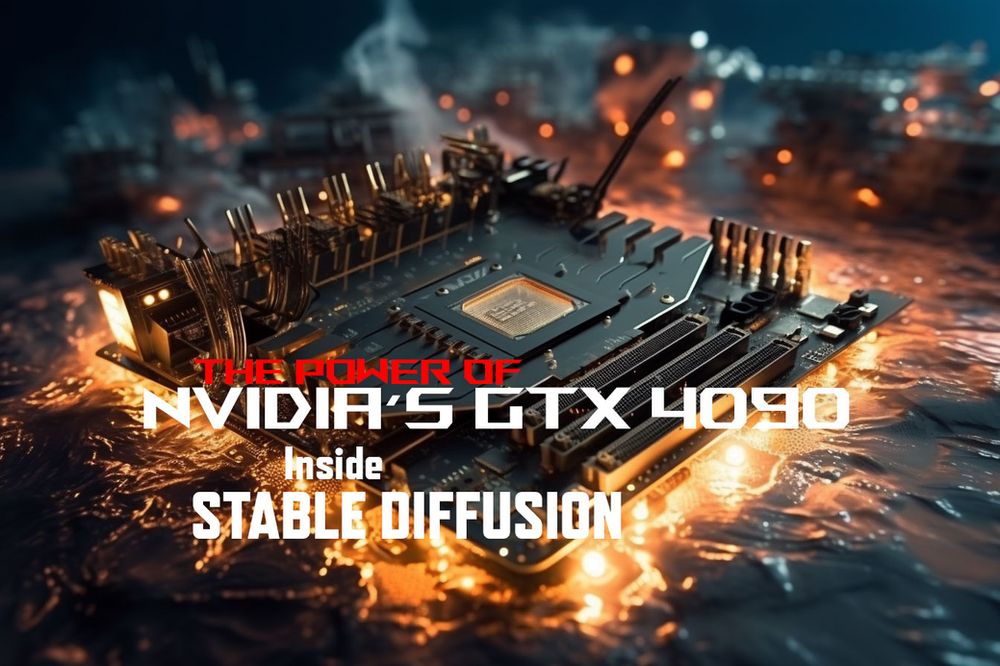
The Power of NVIDIA’s RTX 4090 Performance in Stable Diffusion
AI has been the fastest growing trend in technology I’ve ever experienced in my life time and choosing the right hardware is a critical decision. If you’re a consumer interested in exploring AI tasks like Stable Diffusion, one GPU certainly stands out — NVIDIA’s RTX 4090. Although it may not be the absolute latest or the most potent card in NVIDIA’s arsenal (there are other GPUs specifically designed for professional AI training), the RTX 4090 is a juggernaut in the consumer-level market. Offering a blend of top-tier performance and significant VRAM capacity, it’s an option that packs a punch for Stable Diffusion tasks.
In this article, we will dive into the RTX 4090 performance in Stable Diffusion, and whether its cost justifies its performance. Furthermore, we will discuss how using the command line argument –xformers can optimize its performance even further.
Table of Contents
Is the RTX 4090 a Good Fit for Stable Diffusion?
Yes, the NVIDIA RTX 4090 is an exceptional fit for Stable Diffusion. The powerful specifications of this GPU, including its large VRAM capacity, make it an excellent choice for tasks like Stable Diffusion.
What sets the RTX 4090 apart is its ability to handle high computational loads efficiently, crucial for the image generation tasks typical in Stable Diffusion projects. The advanced Ampere architecture of the RTX 4090, paired with its 24GB GDDR6X VRAM, ensures swift data processing and aids in delivering detailed and accurate AI-generated images.
Moreover, an additional tweak using the command line argument –xformers can further enhance the RTX 4090’s performance in Stable Diffusion tasks. More on that later in this article.
While it’s important to note that there are other GPUs tailored for high-end professional AI training, the RTX 4090 remains an attractive choice in the consumer market. It blends top-tier performance and significant VRAM capacity, proving its worth for tasks like Stable Diffusion.

In this guide, we will explore a hassle-free approach on How to Install Stable Diffusion, a powerful web user interface. What sets this method apart is the utilization of GitHub Desktop, which provides the unique advantage of easy rollback options. By leveraging GitHub Desktop, you gain the ability to effortlessly revert installations of both the…

Is RTX 3060 Good for Stable Diffusion? If you’re considering the NVIDIA RTX 3060 for Stable Diffusion, you’re heading in the right direction. In this blog post, we will learn about the effectiveness and suitability of the NVIDIA GeForce RTX 3060 for Stable Diffusion.
Stable Diffusion RTX 4090 Performance
The RTX 4090’s performance in Stable Diffusion tasks is quite remarkable. The card outperforms many of its counterparts, indicating its potential in handling AI and deep learning tasks.
When compared to other GPUs in the NVIDIA family, the RTX 4090 consistently performs at a higher level. For example, in a testing, the RTX 4090 performed 43% faster than the RTX 3090 Ti without xformers and 50% faster when xformers were enabled.
Even when faced with more complex target resolutions, the RTX 4090 displayed its muscle. In tasks involving a resolution of 2048×1152, the RTX 4090 was a whopping 72% faster than the RTX 3090 Ti without xformers, and an impressive 134% faster with xformers. This shows that the RTX 4090 can really leverage its resources for more complex computational tasks in Stable Diffusion.
It’s also worth noting that the RTX 4090 benefits significantly from the use of xformers. Adding –xformers to your command line can improve performance dramatically, as indicated by the results from our tests. This simple tweak makes the RTX 4090 an even more powerful tool for Stable Diffusion.
Does RTX 4090’s VRAM capacity affect its Stable Diffusion Performance?
The NVIDIA RTX 4090 is loaded with an impressive 48GB of GDDR6X VRAM, giving it a significant edge when running memory-intensive tasks like Stable Diffusion. It’s important to consider the VRAM capacity when dealing with machine learning tasks, as these tasks often require significant memory resources.
In the case of the RTX 4090, its large VRAM capacity ensures that it can handle high-resolution and complex tasks without any issues of memory shortage. During our testing, we didn’t encounter any memory-related issues when using the RTX 4090 for Stable Diffusion, even with higher target resolutions.
In contrast, GPUs with lower VRAM capacities may struggle with memory-related issues when performing similar tasks. Therefore, if you’re looking to run Stable Diffusion tasks with high-resolution targets or complex data sets, the RTX 4090’s large VRAM capacity makes it an excellent choice.
RTX 4090: Performance vs Cost
The NVIDIA RTX 4090 is indeed a high-end card, and as such, it carries a premium price tag. However, it’s essential to consider the balance of cost and performance, especially when dealing with demanding AI tasks such as Stable Diffusion.
Despite the cost, the RTX 4090 offers an unparalleled level of performance for a consumer-level card. In some Stable Diffusion benchmarks, the RTX 4090 outperformed most of the competition, providing speedy and reliable results consistently.
While it might be a significant investment, the exceptional performance justifies the cost, especially for those heavily invested in AI projects or professional image generation tasks. It’s also worth mentioning that the cost-per-TFLOP for the RTX 4090 is better than many other cards in its class, further underlining its value proposition.
In essence, while the initial investment may seem high, the RTX 4090 could prove to be a cost-effective choice in the long run, particularly for those who frequently engage in high-intensity Stable Diffusion tasks. As always, it’s essential to consider your specific needs and budget before making a decision.
Source – Tom’s Hardware | Stable Diffusion Benchmarked: Which GPU Runs AI Fastest
Final Thoughts – RTX 4090 Performance in Stable Diffusion
Researching the myriads of GPUs can be a complex task, especially when the focus is on specific use-cases like Stable Diffusion. The NVIDIA RTX 4090 is not the latest or the most potent GPU on the market for AI training. However, it stands out as an excellent choice for consumer-level usage, delivering an impressive balance of performance, VRAM capacity, and cost.
In testing at Tom’s Hardware, , the RTX 4090 showed exceptional performance in Stable Diffusion tasks, even when compared to more advanced GPUs. Its massive 24GB VRAM allows for smooth handling of complex computations, and when coupled with a command-line argument like –xformers, you can potentially boost the results even further.
Though it might be a substantial investment, the RTX 4090 offers a level of performance that justifies its cost, especially for those engaged in intense Stable Diffusion tasks. Before making a purchase decision, it’s crucial to consider your specific needs, the GPU’s performance, and of course, your budget.
Stable Diffusion Hardware Requirements:
- System Requirements: Your Complete Guide
- Do you need a GPU for Stable Diffusion?
- What GPU is needed for Stable Diffusion?
- How much RAM do you need for Stable Diffusion?
- Is 2gb VRAM enough for Stable Diffusion?
- Is RTX 3060 good for Stable Diffusion?
- How many GPUs do you need to train Stable Diffusion?
- Is 8GB enough for Stable Diffusion? Is 8GB VRAM overkill?
- Do you need an SSD for Stable Diffusion?
- Can Stable Diffusion run on a CPU?
- Should I use CPU or GPU for Stable Diffusion?
- The Power of NVIDIA’s RTX 4090 for Stable Diffusion





Leave a Reply